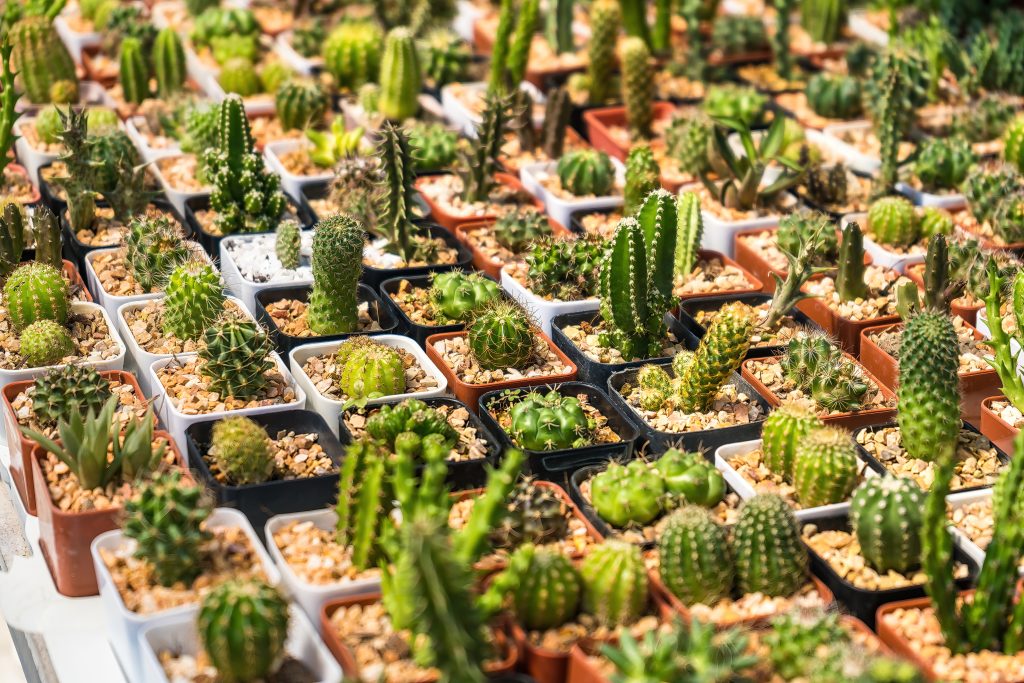Cacti are a member of the Cactaceae family. Most of these fascinating species are considered a part of the succulent family, with a firm plant body and adaptations to store water. There are nearly 2,000 species, each coming in different shapes, sizes, and colors. The tallest cactus on record was a 78 foot Saguaro cactus that unfortunately blew over in 1986. They are native to the Americas, but now can be found all across the world. Cacti are slow growers, gaining a couple of inches in height each year, but can produce brightly colored flowers depending on the amount of sunlight they receive. They have evolved to be covered in spines- both protective and decorative. Despite their spiky and intimidating appearance, this plant is very easy to maintain and can go for long periods of time without needing much attention. They are popular indoor plants due to their ability to thrive in dry climates. Cacti are non-toxic for humans and pets, but can be dangerous due to their spines.
Cacti thrive in bright lighting.
Water with filtered or rain water. In the summer, allow the plant to dry out 90% of the way. In the winter, water when the cactus is 100% dry.
Cacti can tolerate high temperatures, but most are less tolerant of the cold. The Ideal temperature for cacti kept as houseplants is between 50-90 degrees Fahrenheit. Some wild species can handle light freezes, while others are better adapted to handle temperatures surpassing 100 degrees. Most cacti prefer low humidity environments, as high humidity can lead to root rot.
It can be difficult to propagate cacti. Cactus species like the Prickly Pear Cactus that have big segmented paddles can be cut for propagation rather easily, but globular cacti like the Golden Barrel Cactus do not propagate via cutting. Instead, once they have reached a mature enough age, they put new pups out that can be severed at the root and potted as new plants. Cacti with paddles, pups, and/or segments (like the Christmas, Spring, and Thanksgiving Cactus) can be propagated. Simply separate a paddle/pup from the parent cactus and gently plant it into some soil. Let pups grow in their parent pot a little before separating to give it the best shot at a happy, successful life! It will grow roots eventually, just remember that cacti are slow growers, so you’ve got to be extra patient! Newly planted pups or paddles need to be kept slightly more moist than their mature counterparts to help them develop stronger root systems.
Cacti root systems are usually shallow and sparse, making them fragile. Be very gentle when repotting so as to not damage the few roots this plant has.
These plants will need to be repotted infrequently. Gently poke the soil with the stake to loosen the cactus, lift it out of the previous pot, and then transfer it into the new, well-draining container. Make sure to bury the cactus at the same depth at which it was previously buried.
Oftentimes overwatering or inadequate light can lead to partial or total rot. If the cactus has paddles, cut off the paddles that have not rotted from the mother plant. Plant these paddles in soil, place in bright light, and water when the soil has mostly dried out. If you have a taller, round cactus with no pup offshoots, grab a clean knife. Make a clean cut above where the rot ends. The root system and rotten base are not salvageable, but the top portion can be repotted and rooted. Allow for this new section to callus over before placing it in dirt for at least 24 hours. Then, place it in well-draining soil in a bright spot. Eventually the cutting should root and establish itself. Note that these methods are not always successful. Be aware that even with the best care, the new propagations may not survive and the plant will need to be replaced.
